Postmarks of Great Britain & Ireland
Part 2 – Railway Station Postmarks
CLICK HERE for a Bibliography of references to the Station Postmarks of GB & Ireland
We will divide this page into two parts, both of which are based on the books Railway Station Postmarks by DP Gowen (published by the Railway Philatelic Group in 1978) and Postmarks of British & Irish Railway Stations 1840-1997 by WT Pipe (published by the Railway Philatelic Group in 1997).
Part 1 – What are Railway Station Postmarks?
Part 2 – Types of Railway Station Postmark
This page deals with all STATION postmarks, whatever their source, but first we need to dispel a couple of myths.
Myth 1: “Railway Station Postmarks are much the same as Railway Sub Office (RSO) postmarks.” This is simply NOT TRUE – the two are quite different.
Myth 2: “Railway Station Postmarks (with Station or variants thereof in the stamp) are mainly from post offices which happened to be located at or near a railway station, but did not necessarily have a direct connection with the railway.” This is NOT QUITE TRUE. Postmarks containing text such as ‘Station’ (or variants thereof) are thought to have initially been provided only for offices which had been designated as Forward Offices; these offices did have a direct connection with the railway (see below). However, over the years the situation becomes less clear cut (again, see below).
Part 1 – What are Railway Station Postmarks?
Railway Station Postmarks were first applied at ‘Forward Offices’ (see next) and contained the text STATION (or Stn., or Statn. etc). It is undoubtedly true that some such postmarks were also applied at other varied offices. This page deals with all such postmarks, whatever their source.
Forward Offices using Railway Station postmarks
In the days when mail was delivered long distance by horse drawn mail coaches, the Post Office set up Forward Offices (or Forwarding Offices) roughly 100 miles along each route. At a Forward Office, a coach would drop off mail bags for that region. The Forward Office would sort the mail into Post Towns, and deliver them onwards to those Post Towns. These Forward Offices could be thought of as the forerunners of the later Regional Distribution Offices (but on a smaller scale).
When the Post Office started transferring mails from coaches to the railways, they naturally set up similar Forward Offices to process incoming mails delivered down the line by railway. These Forward Offices would usually be at or near a railway station, and would often have STATION in their addresses and postmarks).
Forward Offices were primarily sorting offices and did not normally provide a full range of post office facilities, although they usually had a letter box into which the public could post letters.
The only mails to get a Forward Office postmark were the letters posted directly into the Forward Office. (In some ways you might think of a Forward Office as a stationery TPO, but in a building rather than on a train!). It should be noted, however, that mail in transit was sometimes back stamped (stamped on the back of the letter) to record the date and time of its passage. Such back-stamp postmarks can also be found from Forward Offices.
We will reiterate that most early Railway Station postmarks were applied at Forward Offices or their equivalent, but the following situations muddy the water a little!
Other Offices using Railway Station postmarks
- Out of town Stations: Railways sometimes sited a new station a mile or two from the town it was supposed to serve. In time, small settlements grew up around this station … and were named after the station itself (e.g. Washington Station, to distinguish it from the nearby Washington village). In some cases these settlements acquired their own post offices, which naturally took the name of the settlement, and therefore had the word STATION in their addresses and postmarks. Such post offices had no direct connection with the railway, but the railway was the reason why they were there in the first place!
- Sub-offices: If a post office (for whatever reason) had STATION in its title, any sub-office would have the full name of the parent office in its title (including STATION), even though the sub-office itself might have no connection with the railway. Thus, STATION (or some abreviation thereof) would appear in the postmark of the sub-office. A variant of this is where a sub-office included something like NEAR STATION in its address and postmark.
- Indirect Station references: Some offices included their street address in postmarks. If the address was something like STATION ROAD then this would appear in the postmark.
- Post Offices operated by Railway Staff: Occasionally, a new community post office (not a Forward office) was on the station itself, and initially operated by railway employees. Such offices would normally include STATION in their addresses and postmarks. An example of this was Rannoch Station Post Office, so called to distinguish it from the office in the village of Rannoch. There were also on-station post offices, initially operated by railway employees, which did not include STATION in their title – but, of course, these did not have Railway Station postmarks.
Station Postmarks … but not Railway Stations!
Part 2 – Types of Railway Station Postmark
Here we illustrate Railway Stations Postmarks types 1 to 19 (as originally listed by Gowen in 1978, and modified by Pipe in 1997), followed by types 19 to 24 (as added by Pipe in 1997). Where the two type numbering systems differ, we use Pipe’s numbering. The majority of the illustrations here are from Pipe’s book, but some are from Gowen’s book. Some sub-types are not illustrated here (see Pipe’s book for these).
(You can, of course, sequence your collection of Station Office Postmarks in any order you like. However, the most obvious order is that given below – as in Pipe’s book.)
Unless explicitly stated otherwise, all postmarks below are ‘official’ Post Office marks.
Type 1. Unframed Obliterators (double-arc & single-arc marks, dated and undated ) Breakdown of Type 1 Sub Groups – Unframed Obliterators (as in Pipe’s book) Unframed Obliterators were the earliest type of cancels used in the normal course of Post Office work at railway stations. The first postmarks were dated double arcs (progressing to the dated single ring postmarks used throughout the life of TPOs). Type 1 postmarks had no printed circular frame, and the station name was printed in an outer circle. The gap between the end of the station name and the start of it is completed by including a pair of printed arcs (or in some cases just a single arc). If the station name is split into two parts there can be two pairs of printed arcs. 1a. Double Arc (dated, serif lettering) CLICK HERE to close expanded Type 1 breakdown Type 2. Single Numeral Obliterators Breakdown of Type 2 Sub Groups – Single Numeral Obliterators (as in Pipe’s book) The early Post Office Maltese Cross obliterator did not show the office of origin. In 1844 the Post Office allocated numbers to each post office and started to issue vertical obliterator stamps containing office numbers (referred to as Single Numeral Obliterators as they only contained the office number). Those issued in England and Wales were horizontal oval shapes, whereas those in Scotland were rectangular, and those in Ireland were diamond shaped. [A normal postmark (dated, with station name) was also usually applied separately to letters.]
1844 Type Single Numeral Obliterators 2a. England & Wales – Horizontal Oval, usually 4 bars above & below the office number Later Single Numeral Obliterator issues 2b. 3HOS type – 3 bars above & below number, Horizontal Oval (Single numeral) CLICK HERE to close expanded Type 2 breakdown Type 3. Duplex Postmarks Breakdown of Type 3 Sub Groups – Duplex Postmarks (as in Pipe’s book) Duplex stamps were introduced in 1856. These marks were the natural follow-on from the Type 2 Numeral cancels, and consist of the numeral mark in the obliterator (indicating the station) alongside a dated single ring mark (with station name). Both of these marks were applied at the same time using a single dual purpose handstamp. 3a. English Type Duplex: 3 bars above & below numeral, Vertical Oval Duplex (3VOD), and 4 bars above & below numeral, Vertical Oval Duplex (4VOD) CLICK HERE to close expanded Type 3 breakdown Type 4. Squared Circle Cancels Type 5. Double Ring Cancels (numerous varieties) Breakdown of Type 5 Sub Groups – Double Ring Cancels (as in Pipe’s book) Double Ring cancels were introduced in Scotland in the 1880s. These dated name-stamps initially had the office name at the top and the office number (numeral) at the base between two sets of double arcs. The office numeral was later replaced by a Maltese Cross. Double Ring cancels were introduced in England and Wales in the 1890s (but this format is also known in Scotland). They had the office name at the top, with either the town name, county or region at the bottom. Scottish Type Double Ring Cancels 5a. Numeral at base between arcs, station name above English & Welsh Type Double Ring Cancels (but also used in Scotland) 5f. Station name at top (with town/county or other at bottom) CLICK HERE to close expanded Type 5 breakdown Type 6. Single Ringing Cancels (numerous varieties) Breakdown of Type 6 Sub Groups – Single Ring Cancels (as in Pipe’s book) Single ring cancels came into use in 1850s and have been with us ever since! 6a. Only marks including the text STATION or JUNCTION 6f. No mention of Station, but known to be situated on a station CLICK HERE to close expanded Type 6 breakdown Type 7. Skeleton Stamps (temporary issues – numerous varieties) Breakdown of Type 7 Sub Groups – Skeleton Postmarks (as in Pipe’s book) 7a. Traveller Postmark (unframed skeleton) 7e. Sub-office of a Station Office CLICK HERE to close expanded Type 7 breakdown A Skeleton stamp was really no more than a framework into which date and time slugs and station name text etc. could be inserted. They were issued to offices when the normal stamp was in need of repair or required some change to it. When the normal stamp was available again, the skeleton stamp was withdrawn. Type 8. Rubber Date Stamps (numerous varieties – few illustrations available) Breakdown of Type 8 Sub Groups – Rubber Date Stamps (as in Pipe’s book) 8a. Station Offices – Britain & Ireland CLICK HERE to close expanded Type 8 breakdown Prior to 1885, smaller offices were only issued with undated stamps, but the introduction of the Postal Order system required more security. Dated rubber stamps were issued to these smaller offices rather (than metal ones) because they were cheaper to produce and – as their usage was expected to be less – would probably last as long as the metal ones used in larger offices. Rubber stamps were replaced by metal ones in 1934. Type 9. Hooded / Scroll Postmarks 10a. Metal Oval Registered Postmark (dated) CLICK HERE to close expanded Type 10 breakdown Type 12. Machine/Meter Postmarks Postmarks of types 12a and 12b were all made using Kragg machines. 12a. Machine Cancel) CLICK HERE to close expanded Type 12 breakdown The wavy lines on each side of type 12a marks extend much further than shown here. Type 12c marks can include other embelishments. Type 13. Parcel Post Cancels (double-circle, office name breaks inner circle, undated) Type 16. Parcel Post Cancels (rectangular) 16a. (blank entry – no details available) CLICK HERE to close expanded Type 16 breakdown Type 17. Railway Company Oval Cancels These postmarks are from handstamps belonging to the railway companies. Although found on letters bearing Post Office postage stamps, these postmarks are not ‘official’ Post Office marks. Type 18. Straight Line Cancels These marks may also be railway company marks rather than ‘official’ Post Office marks. Type 19. Inspectors Marks (might be railway company marks) The last four types are less obvious, and require a bit of thought. We recommend that you refer to Pipe’s book for further information about types 21 to 24. Type 21. Instructional Marks The above illustrations should give you good appreciation of the varieties of Station Office postmarks. But don’t forget that there are quite a few sub-varieties not shown here. For those you will have to refer to Postmarks of British & Irish Railway Stations 1840-1997 by W.T. Pipe. CLICK HERE for Postmarks of Great Britain & Ireland – Part 3, Railway Sub Offices (RSOs)
CLICK HERE for an expanded breakdown of Type 1 sub-groups
1b. Double Arc (undated, serif lettering)
1c. Double Arc (dated, sans serif lettering)
1d. Double Arc (undated, sans serif lettering)
1e. Double Arc (dated, sans serif lettering, reduced size) (not illustrated)
1f. Single Arc (dated, sans serif lettering)
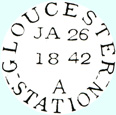
type 1a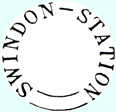

type 1c type 1d
type 1d
type 1f
CLICK HERE for an expanded breakdown of Type 2 sub-groups
2Ba. Scotland – Rectangular, 3 bars above & below the office number
2Ca. Ireland – Diamond shaped, 5 bars above & below the office number
2c. 4VOS type – 4 bars above & below number, Vertical Oval (Single numeral)
2d. 3VOS type – 3 bars above & below number, Vertical Oval (Single numeral)

type 2a
(Eng/Wales)
type 2b
type 2d
type 2Ba
(Scotland)
type 2Ca
(Ireland)
CLICK HERE for an expanded breakdown of Type 3 sub-groups
3b. Sideways Duplex: vertical oval, but number also vertical (Farnboro’ Station only)
3c. English Type Duplex: (not Station Office, but near Station, Station Road etc)
3d. Scottish Type Duplex: obliterator roughly rectangular, 2 bars above and below numeral
3e. Irish Type Duplex (not seen, not illustrated)
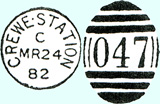
type 3a
(England)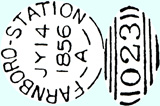
type 3b
(sideways)
type 3d
(Scotland)

type 4a
(3 broken Circles)
type 4a
(3 broken circles)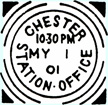
type 4a
(2 broken circles)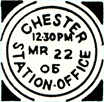
type 4a
(1 broken circle)
CLICK HERE for an expanded breakdown of Type 5 sub-groups
5b. Scotland – Rectangular, 3 bars above & below station number
5c. Maltese Cross at base between arcs, station name above
5d. Maltese Cross at base (no station name – known to be on a station)
5e. (error in office number – Craigellachie only)
5g. (as 5f above, but no mention of Station – known to be situated on a station)
5h. (as 5f above, but Station or Station Office removed)
5i. (as 5f above, but being a sub-office of station office)
5j. (not situated on a station, but containing the word Station)

type 5a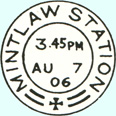
type 5c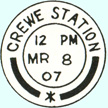
type 5f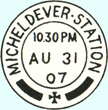
type 5f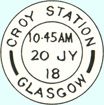
type 5f
CLICK HERE for an expanded breakdown of Type 6 sub-groups
6b. With Station Name at the top, and STATION OFFICE at the bottom
6c. With Station Name at the top, and Town/County/District at the bottom
6d. With Station Name at top, and Railway Company Name (or abreviation) at bottom
6e. With continuous wording right round the ring
6g. STATION OFFICE removed
6h. Sub office of a Station Office
6i. Not on a station, but mentioning STATION or similar
6j. Self-inking Datestamp (the latest inovation from the Post Office)

type 6a
(Station
name only)
type 6b
("STATION OFFICE")
type 6c
(county etc
at bottom)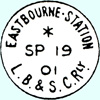
type 6d
(railway name
at bottom)
type 6e
(continuous text round circle)
CLICK HERE for an expanded breakdown of Type 7 sub-groups
7b. Framed circular metal handstamp (England, Scotland, Wales)
7c. Rubber Skeleton (text in straight lines across circular frame)
7d. Framed circular metal handstamp (Ireland)
7f. STATION, RLY STN or similar mentioned in wording
7g. (Stn removed)
7h. No mention of STATION, but known to have been situated on a station
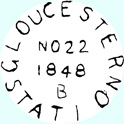
type 7a
(no circular border)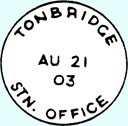
type 7b
(text around border)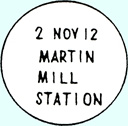
type 7c
(all text horizontal)
CLICK HERE for an expanded breakdown of Type 8 sub-groups
8b. No mention of STATION, but known to be situated on a station
8c. Sub Office of a Station Office
8d. Sub Office of a Station Office, but no mention of STATION
8e. Not a Station Office, but includes the word STATION or similar
8f. (station removed)
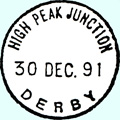
type 8a
(station name at top)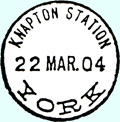
type 8a
(station name at top)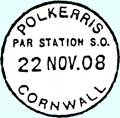
type 8c
(station name horizontal)
Type 10. Oval Registered Postmarks
Type 11. Returned Letter (RL) Postmarks
CLICK HERE for an expanded breakdown of Type 10 sub-groups
Breakdown of Type 10 Sub Groups – Oval Registered Postmarks (as in Pipe’s book)
10b. Rubber Oval Registered Postmark (dated)
10c. Rubber Oval Registered Postmark (undated)
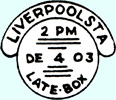
type 9a
(Late Box)
type 9b
(Parcel Post)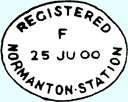
type 10a
(Registered)
type 11
(Returned Letter)
CLICK HERE for an expanded breakdown of Type 12 sub-groups
Breakdown of Type 12 Sub Groups – Machine Cancels (as in Pipe’s book)
12b. Machine Cancel (STATION not mentioned, but known to be situated on a station)
12c. Metered Mail postmarks

type 12a (Bedlington)
(machine cancel only)
type 12a (Bridlington)
(machine cancel only)
type 12c (metered mail)
(postage stamp plus cancel)
Type 14. Parcel Post Cancels (single-circle, 6 or 7 horizontal lines, undated)
Type 15. Parcel Post Cancels (single-circle, dated)

type 13
type 13
type 14
type 14
type 15
CLICK HERE for an expanded breakdown of Type 16 sub-groups
Breakdown of Type 16 Sub Groups – Parcel Post Cancels (as in Pipe’s book)
16b. Rubber Cancel – undated (not seen)
16c. Rubber Cancel – rectangular, dated
16d. Rubber Cancel – revised rectangular design, dated
16e. Not a Station Office, but includes the word STATION or variants
16f. Sub Office of a Station Office (not seen)
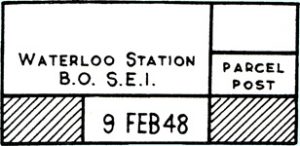
type 16c
(rubber stamp, dated)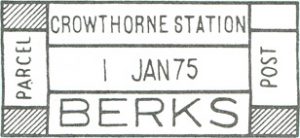
type 16d
(rubber stamp, dated)
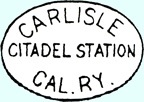
type 17
type 17
type 17
![]()
type 18
type 18
Type 20. Missent Marks

type 19 (Inspector's mark)(in blue, black or green ink)(known only at York)![]()
type 20![]()
type 20
Type 22. Postage Due Marks
Type 23. Telegraph Codes (as found on parcel post labels)
Type 24. Travelling Post Office Cancels with Station Connections
![]()
type 21a
type 22a
type 23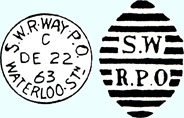
type 24e